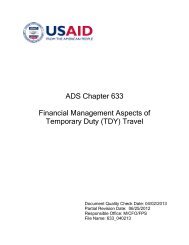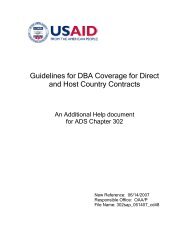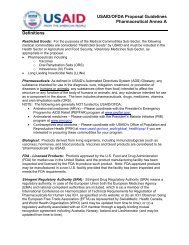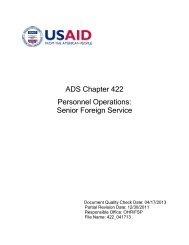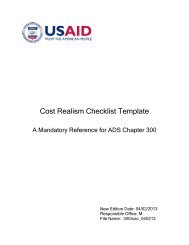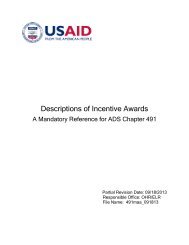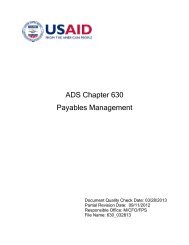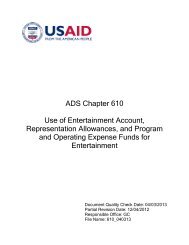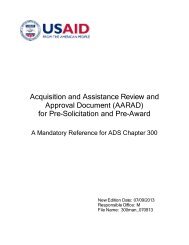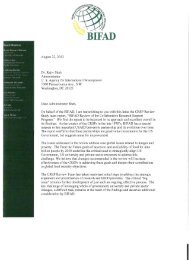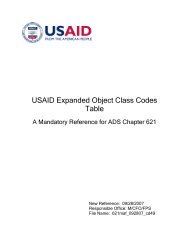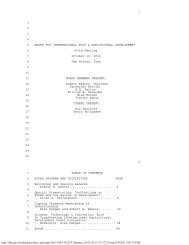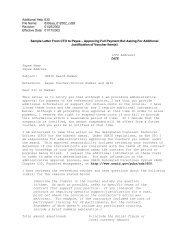ADS 567 Classified Contracts, Grants, Cooperative ... - usaid
ADS 567 Classified Contracts, Grants, Cooperative ... - usaid
ADS 567 Classified Contracts, Grants, Cooperative ... - usaid
Create successful ePaper yourself
Turn your PDF publications into a flip-book with our unique Google optimized e-Paper software.
<strong>ADS</strong> Chapter <strong>567</strong><strong>Classified</strong> <strong>Contracts</strong> and AwardsUnder USAID’s National Industrial SecurityProgramDocument Quality Check Date: 11/12/2012Full Revision Date: 05/29/2012Responsible Office: SEC/CTISFile Name: <strong>567</strong>_111212
05/29/2012 Full Revision<strong>ADS</strong> <strong>567</strong> - <strong>Classified</strong> <strong>Contracts</strong> and Awards Under USAID’s National IndustrialSecurity Program<strong>567</strong>.1 OVERVIEWEffective Date: 05/29/2012The National Industrial Security Program (NISP) serves as a single, cohesive industrialsecurity program to protect classified information and to preserve our nation's economicand technological interests. (See Executive Order (EO) 12829, for the protection ofinformation classified under EO 13526 as amended, or its successor or predecessororders, and the Atomic Energy Act of 1954 as amended, and 12 FAM 570.)The National Security Council is responsible for providing overall policy direction for theNISP. The Secretary of Defense has been designated Executive Agent for the NISP bythe President. The Director, Information Security Oversight Office (ISOO), isresponsible for implementing and monitoring the NISP and for issuing implementingdirectives that are binding on Federal agencies.USAID uses a large number of institutional contractors and grant/cooperativeagreement recipient employees to perform various missions and functions. The USAIDIndustrial Security Program is in place to ensure that these contract and recipientemployees safeguard Federal Government classified information. The program isguided by EO 12829, the National Industrial Security Program Operating Manual(NISPOM), and Homeland Security Presidential Directive 12 (HSPD-12).This <strong>ADS</strong> chapter provides the policy directives and required procedures for USAID’sNational Industrial Security Program. It provides policy directives and requiredprocedures and guidance on the security requirements and language for acquisition andassistance awards falling under the provisions of the NISP. Such contracts orassistance awards require the contractor or recipient to obtain a facility securityclearance (FCL) in order for the contractor or recipient employees to have access toclassified information or restricted areas.This chapter does not address background investigations or the Facility Accessinvestigative process. Security clearance actions regarding U.S. Personal Service<strong>Contracts</strong> and other employee categories can be found in <strong>ADS</strong> 566, PersonnelSecurity Investigations and Clearances.This chapter also does not address the badge issuance process for access to USAIDfacilities. See <strong>ADS</strong> 565, Physical Security Programs (Domestic).<strong>567</strong>.2 PRIMARY RESPONSIBILITIESEffective Date: 05/29/2012The following Bureaus/Independent Offices (B/IOs) have primary responsibilities forspecific policy directives and required procedures within this chapter.<strong>ADS</strong> Chapter <strong>567</strong>3
05/29/2012 Full Revisiona. The Director, Office of Security (D/SEC) is the senior Agency officialresponsible for enforcing Executive Order 12829, <strong>Classified</strong> National IndustrialSecurity Program and HSPD-12.b. The Office of Security, Industrial Security Program Manager (ISPM)(1) Issues USAID security policies and standards;(2) Serves as liaison to the Department of Defense, Defense Security Service(DSS) regarding the National Industrial Security Program; and(3) Coordinates corrective action with contractors, award recipients and/or theDSS when employees fail to comply with the security requirements of theircontracts or awards.c. Bureau/Independent Offices (B/IOs) and USAID Overseas Mission ProjectOfficers are responsible for providing the security specifications to be included incontracts or assistance awards to the B/IO Contracting Officer (CO) or ExecutiveOfficer (EXO).d. Contracting Officers (COs) and Agreement Officers (AOs) and MissionExecutive Officers are responsible for inserting security specifications intocontracts and assistance awards.e. Contracting Officer’s Representatives (CORs) and Agreement Officer’sRepresentatives (AORs) are responsible for assisting COs and AOs(respectively) with establishing and administering security specifications forcontracts and assistance awards. COR and AOR duties include monitoringclassified contractors’ and recipients’ compliance with the security specificationsincluded in their contracts, grants, and cooperative agreements, and notifying thecontracting or agreement officer and SEC of any problems or suspected noncompliancewith these contract requirements.The COR and AOR must be familiar with the security specifications in the awardsfor which they are a COR or AOR and with the USAID regulations that apply.These include <strong>ADS</strong> 545, Information System Security, and <strong>ADS</strong> 565, PhysicalSecurity Programs (Domestic), as well as <strong>ADS</strong> <strong>567</strong>.f. Bureau/Independent Office (B/IO) Administrative Management Specialists(AMSs) are responsible for ensuring that Visit Authorization Letters (VALs) arecompleted and delivered to SEC Domestic Security (SEC/DS).g. Contractor Facility Security Officers (FSOs) are responsible for initiating VALson all cleared contractor employees who access USAID spaces in the performanceof their contract.<strong>ADS</strong> Chapter <strong>567</strong>4
05/29/2012 Full Revisionh. Department of Defense, Defense Security Service (DSS) Industrial SecurityRepresentatives oversee cleared contractor facilities and assist the contractormanagement staff and FSOs in formulating their security programs and obtainingpersonnel security clearances and facility clearances.<strong>567</strong>.3 Policy Directives and Required ProceduresEffective Date: 05/29/2012USAID program, project, and contracting personnel must consider Federal securityrequirements at the earliest possible stage in the procurement process. This sectionprovides the required security policies and mandatory procedures that USAID must applyin creating and administering contracts and grants/cooperative agreements. This chapterapplies to recipients of grants or cooperative agreements to the same extent as tocontractors if the terms and conditions of their awards require their employees to haveunescorted access to USAID restricted space and/or access to classified information, asdescribed below.<strong>567</strong>.3.1 Determining Contract or Award Security LevelsEffective Date: 05/29/2012a. Pre-Award ProceduresThe B/IO or Mission Project Officer must first determine whether a contract or assistanceaward performance will be classified.A contract or assistance award will be classified if:The contractor or recipient employees will require unescorted access toUSAID restricted space within USAID/W, and/orThe contractor or recipient employees will require access to classifiedinformation.Contractor or recipient employees working under a classified contract or assistanceaward require a security clearance. If the contractor or recipient employees are notworking under a classified contract or assistance award, they will need a Facility Access(formerly known as Employment Authorization) and therefore would not fall under this<strong>ADS</strong> chapter. The Facility Access process is discussed in <strong>ADS</strong> 566, PersonnelSecurity Investigations and Clearances.If a contract or assistance award is determined to be classified, it does not mean thatthe terms within the contract or assistance award are classified. It focuses on the typeof access that is required: access to classified information or restricted space.<strong>ADS</strong> Chapter <strong>567</strong>5
05/29/2012 Full Revisionb. Security LanguageIf the B/IO or Mission Project Officer determines a contract or assistance award to beclassified, the COR or AOR must obtain specific security language from the IndustrialSecurity Program Manager (ISPM) through SECNISP@<strong>usaid</strong>.gov and must then provideit to the CO or AO for inclusion in the contract or assistance award. Without thislanguage, contractor and recipient employees cannot gain unescorted access torestricted space in AID/W nor have access to classified materials.c. Post-Award ProceduresIf the contract is granted prior to the inclusion of the required security language clause,an amendment/modification must be made to ensure it is incorporated into the contractor assistance award.<strong>567</strong>.3.2 Facility ClearanceEffective Date: 05/29/2012a. According to the NISPOM, if the contract or assistance award is determined to beclassified, the contractor or recipient must have or be able to maintain a valid Facility(Security) Clearance (FCL) equal to the level of Secret or Top Secret, as specified in thecontract or award. This is required to ensure classified information entrusted to theprivate sector is properly safeguarded. Exceptions to this must be approved by SEC incoordination with the CO/AO and requiring office and will be granted on a case-by-casebasis.USAID SEC will prohibit a contractor or award recipient without a valid Facility Clearancefrom gaining access to USAID restricted space and will deny the contractor or recipientemployees access to classified information. An FCL is obtained through the DefenseSecurity Service (DSS).To obtain an FCL, the contractor or recipient must complete the following steps:1) SponsorshipContractors or recipients must be sponsored for a Department of Defense (DoD)facility security clearance by a Government entity and apply for one through theDSS. The Government entity that sponsors a contractor or recipient will be theUSAID B/IO through which the contractor or recipient employee will be working.The Government entity will provide the contractor or recipient with a sponsorshipletter.USAID SEC does not sponsor contractors or recipients for an FCL or personnelsecurity clearance, nor does it represent the contractor or recipient employee inhis/her effort to obtain such clearances from the DSS. USAID SEC does notprepare documentation, other than a mandatory draft DD 254 – Contract SecurityClassification Specification Form on behalf of a company for submission of an<strong>ADS</strong> Chapter <strong>567</strong>6
05/29/2012 Full RevisionFCL application to the DSS. Applying for an FCL is the sole responsibility of thecontractor or recipient.2) Contract Security Classification Specification Form, DD254The DSS requires contractors or recipients to have a draft DD 254 when applyingfor an FCL. The COR or AOR can request the form from SECNISP@<strong>usaid</strong>.govand must assist SEC in preparing it. The COR or AOR must inform the ISPM whenan FCL is issued. The Industrial Security group will issue a non-draft DD 254when the DSS grants the contractor or recipient an FCL.Block 13 of the DD 254 provides supplemental security guidance that incorporatessecurity specifications into the contract or award. The COR or AOR is responsiblefor immediately communicating any changes in the FCL status to the ISPM.3) Submission of Request to DSSThe contractor or recipient must submit the sponsorship letter, DD 254, and anyadditionally required paperwork to DSS.DSS controls the Facility Clearance process. The process of applying for an FCLand the required paperwork is detailed on the DSS Web site,http://www.dss.mil/isp/fac_clear/fac_clear_check.html. An example of thesponsorship letter is also included on this Web site.<strong>567</strong>.3.3 Security Procedures for Acquisition and Assistance AwardsEffective Date: 05/29/2012After the award, the COR or AOR must send an electronic copy of the contract orassistance award document to SECNISP@<strong>usaid</strong>.gov along with the Commercial andGovernment Entity (CAGE) code for the contractor or recipient. The CAGE code isprovided by DSS when an FCL is issued.The ISPM will review the contract or assistance award to ensure the correct securitylanguage is included and will verify the FCL with the DSS. Once verified, the ISPM willissue a complete form DD 254 to the COR or AOR for modifying into the contract.<strong>567</strong>.3.4 Security ClearanceEffective Date: 05/29/2012Contractor or recipient employees who need access to restricted space within USAID/Wand/or access to National Security Information when there is a job-related “need-toknow”must obtain a security clearance from the DSS’ Defense Industrial SecurityClearance Office (DISCO). The COR, AOR, and Facility Security Officer (FSO) mustwork together to submit to the DSS all such security clearance requests or inquiries.USAID SEC/PS does not conduct background investigations for the adjudication ofsecurity clearances for contractor or recipient employees. These investigations are<strong>ADS</strong> Chapter <strong>567</strong>7
05/29/2012 Full Revision<strong>567</strong>.3.7 Subcontractors/SubrecipientsEffective Date: 05/29/2012Prime contractors or recipients issue DD 254s for subcontractors or subrecipients.Prime contractor/recipient FSOs must provide the subcontractor’s/subrecipient’s DD254 to the USAID ISPM to demonstrate that the subcontractor/subrecipient has therequisite facility clearance for the level of security classification. If the prime contract oraward is classified , then the subcontract/subrecipient under that same contract/awardnumber will be considered a classified subcontract or sub-award. A prime contractor orrecipient cannot subcontract or sub-award any part of a classified contract or award to acompany or recipient that does not have a facility clearance. Excluded from this aresubcontracts or procurements of commercial goods or services unless they requireaccess to classified information and/or restricted space.If the subcontractor/subrecipient DD 254 is not shared with the USAID ISPM, thesubcontractor/subrecipient employees will not obtain access to USAID facilities or aFacility Access Card (FAC).<strong>567</strong>.3.8 Suspension of Contractor Physical AccessEffective Date: 05/29/2012SEC may suspend physical access to USAID offices when there are grounds toquestion an employee’s continued access eligibility.When SEC suspends an individual's physical access, SEC must notify the following, inwriting, of the suspension and the reasons for the action:The individual,The COR/AOR,The CO/AO, andDSS, if applicable.DSS reserves the right to suspend security clearances issued by them in accordancewith DSS policies and procedures.<strong>567</strong>.3.9 Contract/Assistance Award CompletionEffective Date: 05/29/2012The COR or AOR must notify the ISPM when the contract or assistance award is eithercompleted (final delivery of goods or services), or the period of the contract orassistance award ends or is terminated, whichever occurs first. The ISPM willcoordinate with the COR or AOR to ensure contractor or recipient access to Agencyinformation and facilities is terminated (see 12 FAM 575.5).<strong>ADS</strong> Chapter <strong>567</strong>9
05/29/2012 Full RevisionAt the point the contractor or recipient employee no longer requires a USAID-issuedbadge, the COR or AOR is responsible for ensuring that the FSO for the parentcompany returns the badge to SEC at the conclusion of the contract or award or whenthe employee is no longer working under the mechanism in which the badge wasissued.<strong>567</strong>.4 MANDATORY REFERENCES<strong>567</strong>.4.1 External ReferencesEffective Date: 05/29/2012a. 12 FAM 260, Counterintelligenceb. 12 FAM 570, Industrial Security Programc. 12 FAM 573.2-1, Self-Employed Contractorsd. 12 FAM 577, Clearance Processinge. Atomic Energy Act of 1954f. EO 12829, "National Industrial Security Program," of January 6, 1993g. EO 13467, “Reforming Processes Related to Suitability for GovernmentEmployment, Fitness for Contractor Employees, and Eligibility for Accessto <strong>Classified</strong> National Security Information,” of June 30, 2008h. EO 13526, "<strong>Classified</strong> National Security Information," of December 29, 2009i. Federal Register – Volume 58 No. 5 – Friday, January 8, 1993 PresidentialDocumentsj. The Freedom of Information Act, 5 U.S.C. 552k. http://www.dss.mil/isp/fac_clear/fac_clear_check.html(This Web site provides procedures on obtaining a facility clearance.)l. The National Industrial Security Program Operating Manual (NISPOM)m. The Privacy Act of 1974, 5 U.S.C. 552a<strong>567</strong>.4.2 Internal Mandatory ReferencesEffective Date: 05/29/2012a. <strong>ADS</strong> 302, USAID Direct <strong>Contracts</strong><strong>ADS</strong> Chapter <strong>567</strong>10
05/29/2012 Full Revisionb. <strong>ADS</strong> 565, Physical Security Programs (Domestic)c. <strong>ADS</strong> 566, Personnel Security Investigations and Clearancesd. <strong>ADS</strong> 569, Counterintelligence Program<strong>567</strong>.4.3 Mandatory FormsEffective Date: 05/29/2012a. AID Form 6-1, Request for Security Actionb. AID Form 500-1, Request for Issue (or Reissue) of Building Passc. AID 500-3, Security Investigation and Clearance Recordd. DD 254, Contract Security Classification Specificatione. FD-258, Fingerprintf. Standard Form 85P, Questionnaire for Public Trust Positions<strong>567</strong>.5 ADDITIONAL HELPEffective Date: 05/29/2012a. National Industrial Security Program (NISP) Related Questions -SECNISP@<strong>usaid</strong>.govb. Statement of Work Security Clause for <strong>Classified</strong> <strong>Contracts</strong><strong>567</strong>.6 DEFINITIONSEffective Date: 05/29/2012The terms and definitions listed below have been incorporated into the <strong>ADS</strong> Glossary.See the <strong>ADS</strong> Glossary for all <strong>ADS</strong> terms and definitions.accessThe ability and opportunity to obtain knowledge of classified information. An individualis considered to have access by being in a place where national security information iskept, processed, handled, or discussed, if the security control measures that are in forcedo not prevent that person from gaining knowledge of such information. (Chapters 562,566, <strong>567</strong>, 568)Agreement Officer (AO)A person with the authority to enter into, administer, terminate and closeout assistanceagreements, and make related determinations and findings on behalf of USAID. AnAgreement Officer can only act within the scope of a duly authorized warrant or othervalid delegation of authority. The term "Agreement Officer" includes persons warranted<strong>ADS</strong> Chapter <strong>567</strong>11
05/29/2012 Full Revisionas "Grant Officers." It also includes certain authorized representatives of the AgreementOfficer acting within the limits of their authority as delegated by the Agreement Officer.(Chapters 303, 304)A person representing the U.S. Government through the exercise of his/her delegatedauthority to enter into, administer, and terminate contracts and make relateddeterminations and findings. This authority is delegated by one of two methods: to theindividual by means of a “Certificate of Appointment”, SF-1402, as prescribed in FAR1.603-3, including any limitations on the scope of authority to be exercised, or to thehead of each contracting activity (as defined in AIDAR 702.170), as specified in AIDAR701.601. (Chapters 302, 306, 331)Agreement Officer's Representative (AOR)The individual who performs functions that are designated by the Agreement Officer, oris specifically designated by policy or regulation as part of the administration of anassistance award (grant or cooperative agreement). (Chapter <strong>567</strong>)classified award<strong>Contracts</strong>, grants, or cooperative agreements with positions requiring access toclassified information and/or designated Restricted Space. These procedures areapplicable to licensees, grantees, and certificate holders to the extent legally andpractically possible within the constraints of applicable law and the Code of FederalRegulations. (Chapters 562, <strong>567</strong>)classified national security information (classified information) Any data, file,paper, record, or computer screen containing information associated with the nationaldefense or foreign relations of the United States and bearing the markings: Confidential,Secret, or Top Secret. (Chapters 545, 552, and 568)Information that has been determined pursuant to E.O. 12958 or any predecessor orderto require protection against unauthorized disclosure and is marked (Confidential,Secret, or Top Secret) to indicate its classified status when in documentary form. It isalso referred to as classified information.a. Confidential: Information, the unauthorized disclosure of which reasonably could beexpected to cause damage to the national security that the original classificationauthority is able to identify or describe.b. Secret: Information of which the unauthorized disclosure could reasonably beexpected to cause serious damage to the national security.c. Top Secret: Information of which the unauthorized disclosure could reasonably beexpected to cause exceptionally grave damage to the national security. (Chapters 545,552, 562, 566, <strong>567</strong>)<strong>ADS</strong> Chapter <strong>567</strong>12
05/29/2012 Full Revisioncleared contractorAny industrial, educational, commercial, or other entity that has been granted a FacilityClearance (FCL) by a Cognizant Security Agency (CSA). (National Industrial SecurityProgram Operating Manual (NISPOM)) (Chapter <strong>567</strong>)contractor employeeRefers only to U.S. citizens employed as an independent contractor, fellow, institutionalcontractor, or any other category of individual, not a direct-hire, potentially requiring asecurity clearance to work on USAID information or material or have unescorted accessin USAID space. (Chapter <strong>567</strong>)Contracting Officer (CO)A person representing the U.S. Government through the exercise of his or herdelegated authority to enter into, administer, and terminate contracts and make relateddeterminations and findings. This authority is delegated by one of two methods: to theindividual by means of a "Certificate of Appointment," SF 1402, as prescribed in FAR1.603-3, including any limitations on the scope of authority to be exercised, or to thehead of each contracting activity (as defined in AIDAR 702.170), as specified in AIDAR701.601. (Chapters 302, 331, <strong>567</strong>)Contracting Officer’s Representative (COR)The individual who performs functions that are designated by the Contracting Officer, oris specifically designated by policy or regulation as part of contract administration.(Chapter <strong>567</strong>)cognizant security agencies (CSAs)Agencies of the Executive Branch that have been authorized to establish an industrialsecurity program to safeguard classified information when disclosed or released to U.S.industry. (Chapter <strong>567</strong>) (NISPOM)direct-hire employeeRefers only to U.S. citizens employed as direct-hire (general schedule Civil Service) andexcepted service (non-career and Foreign Service), expert, consultant, or AdvisoryCommittee Member Serving without Compensation working for USAID. (Chapters 562,566, <strong>567</strong>)facility accessA determination based on investigative action that an individual is eligible to occupy anon-sensitive position. Facility access grants an individual access to Sensitive ButUnclassified Information (SBU) at the discretion of the holder of the SBU material.Facility access also grants the individual access to USAID-sensitive informationtechnology systems at the discretion of the responsible system administrator. SEC hasthe authority to withdraw facility access at any time, and such action is not subject toappeal. (Chapter <strong>567</strong>)<strong>ADS</strong> Chapter <strong>567</strong>13
05/29/2012 Full RevisionFacility Access Card (FAC)An identification card issued to employees, detailees, or contractors who do not qualifyfor a Federal ID card or who do not represent USAID to other agencies. (Chapter <strong>567</strong>)facility (security) clearance (FCL)According to the National Industrial Security Program Operating Manual (NISPOM), anadministrative determination that, from a national security standpoint, a facility is eligiblefor access to classified information at the same or lower classification category as theclearance being granted. (Chapter <strong>567</strong>)Federal credentialA standardized form of identification as prescribed by Homeland Security PresidentialDirective (HSPD) 12 that (a) is issued based on sound criteria for verifying an individualemployee's identity; (b) is strongly resistant to identity fraud, tampering, counterfeiting,and terrorist exploitation; (c) can be rapidly authenticated electronically; and (d) isissued only by providers whose reliability has been established by an officialaccreditation process. (Chapters 565, <strong>567</strong>)institutional contractor employeeAn individual who performs work for on or behalf of any Agency under a contractor andwho, in order to perform work specified under the contract, will require access to space,information, information technology systems, staff or other assets of the FederalGovernment. Such contracts, include, but are not limited to services contracts,contracts between any non-Federal entity and any agency, and sub-contracts betweenany non-Federal entity and another non-Federal entity to perform work related to theprimary contract with the agency. (Chapter <strong>567</strong>)need-to-knowA determination made by a possessor of classified information that a prospectiverecipient, in the interest of national security, needs access to, knowledge, or possessionof the classified information in order to perform official duties. The determination is notmade solely by virtue of an individual's office, position, or security clearance level.(Chapters 562, 566, <strong>567</strong>, 568)personnel security investigationInquiries designed to develop information pertaining to an individual for use indetermining whether the employment, assignment to duties, or retention in employmentof that individual is clearly consistent with the interests of national security and USAIDgoals and objectives. (Chapters 566, <strong>567</strong>)recipientAn organization receiving direct financial assistance (a grant or cooperative agreement)to carry out an activity or program. (Chapters 303, 304, 305, <strong>567</strong>)recipient employee<strong>ADS</strong> Chapter <strong>567</strong>14
05/29/2012 Full RevisionAn individual that is working for a recipient. (Chapter <strong>567</strong>)restricted spaceAn area where storage, processing, discussions, and handling of classifiedmaterial is authorized. (Chapters 565, <strong>567</strong>)security clearanceA certification that a U.S. citizen, who requires access to information classified at acertain level, has been found security eligible under federal standards and may bepermitted access to classified information at the specified level. (Chapters 562, 566,<strong>567</strong>)security eligibilityA security status based on favorable adjudication of a required personnel securityinvestigation; it indicates that an individual is deemed trustworthy for employment in asensitive position, and may be granted a clearance for access to classified informationup to the level of eligibility if required in the performance of official duties. (Chapters562, 566, <strong>567</strong>)sensitive but unclassified information (SBU)SBU describes information which warrants a degree of protection and administrativecontrol that meets the criteria for exemption from public disclosure set forth underSections 552 and 552a of Title 5, United States Code: the Freedom of Information Actand the Privacy Act, 12 FAM 540 – Sensitive but Unclassified Information, (TL;DS 61;1001 199), 12 FAM 541 Scope, (TL;DS 46;05 26 1995). SBU includes, but is not limited to:• Medical, personnel, financial, investigatory, visa, law enforcement, orother information which, if released, could result in harm or unfairtreatment to any individual or group, or could have a negative impact uponforeign policy or relations; and• Information offered under conditions of confidentiality which arises in thecourse of a deliberative process (or a civil discovery process), includingattorney-client privilege or work product, and information arising from theadvice and counsel of subordinates to policy makers. (Chapters 545, 552,562, 566, <strong>567</strong>)suitabilitySuitability refers to the basic standard (in EO 10450) requiring that an individual'sappointment to, or retention in, the Federal Service must promote the efficiency of theService. Suitability is only applicable to direct-hire employees. (Chapters 562, 566, <strong>567</strong>)temporary facility accessA determination that an individual is eligible to occupy a non-sensitive position. SECgrants temporary facility access pending a more in-depth personnel securityinvestigation. (Chapter <strong>567</strong>)<strong>ADS</strong> Chapter <strong>567</strong>15
05/29/2012 Full Revisiontemporary security clearanceA certification based on partial investigative action that a U.S. citizen, who requiresaccess to information classified at a certain level, has been found security-eligible underUSAID standards (authority #16) and may be permitted access to classified informationat the specified level. The temporary clearance may be withdrawn at any time. Ifwithdrawn, the individual will be advised of the issue requiring resolution, however theindividual has no right to appeal the decision. The clearance will remain temporary untilthe personnel security investigation is completed and favorably adjudicated at whichtime the temporary designation is withdrawn. (Chapters 566, <strong>567</strong>)unrestricted spaceAn area where storage, processing, discussion, and handling of classified material isnot authorized. (Chapters 565, <strong>567</strong>)USAID/WRefers to all Washington, D.C. office locations, including but not limited to the RonaldReagan Building, SA-44, and Potomac Yards II. (Chapter <strong>567</strong>)visit authorization letter (VAL)A request by an institutional contractor to enter a USAID facility to perform services.(Chapter <strong>567</strong>)<strong>567</strong>_111212<strong>ADS</strong> Chapter <strong>567</strong>16



